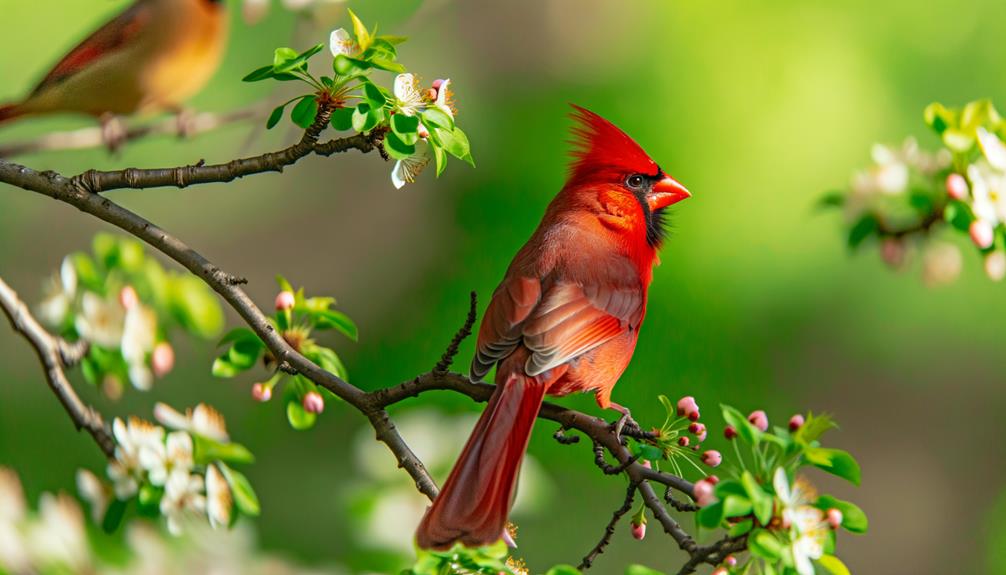Do Cardinals Attract a Mate: Courtship 101
Male cardinals attract mates by showcasing vibrant red feathers and intricate flight patterns, catching the female's eye. Their complex and melodious songs play a pivotal role, signaling vocal prowess and territorial dominance.
They engage in song battles and physical confrontations to secure larger, well-defended territories rich in food and nesting sites. Additionally, males perform courtship behaviors, like mutual preening and courtship feeding, to solidify bonds.
The intensity of their red plumage, enhanced by a carotenoid-rich diet, indicates good health and superior genetics. If you're curious about the connection between these fascinating behaviors and mating success, there's more to discover.

Key Takeaways
- Cardinals use vibrant red plumage to signal good health and genetic quality.
- Intricate and frequent songs attract females by showcasing vocal prowess.
- Males demonstrate agility and fitness through complex flight patterns.
- Territorial displays and song battles assert dominance and attract mates.
- Courtship feeding displays foraging skills and strengthens pair bonds.
Visual Displays

In their pursuit to attract a mate, male cardinals engage in vibrant visual displays, showcasing their bright red feathers and precise, dynamic movements. You'll notice these males positioning themselves in well-lit areas to maximize the visibility of their feathers.
This bright coloration is a sign of health and importance, making them more appealing to potential mates. Studies have shown that females prefer males with more intense red plumage, as it indicates better nutrition and overall genetic fitness.
Additionally, males perform intricate flight patterns and perching behaviors, drawing attention with their agility and coordination. These visual cues serve as a confirmation of their physical fitness, increasing their chances of securing a mate through impressive and strategic displays.
Melodious Songs
Beyond their visual displays, male cardinals captivate potential mates with melodious songs that demonstrate their vocal prowess and territorial dominance. You'll notice their complex vocalizations, often consisting of clear whistles and repetitive phrases.
Studies show that females prefer males with more intricate and frequent songs, as these indicate robust health and genetic fitness. You can observe males singing from high perches, making their presence known while warding off rivals.
Research has confirmed that the variety and complexity of these songs are directly correlated to mating success. By mastering these vocal displays, male cardinals effectively communicate their suitability as mates, ensuring that they attract the most discerning females.
This strategy underscores the importance of auditory signals in avian courtship rituals.
Territory Establishment

Frequently, male cardinals establish and defend territories through aggressive displays and physical confrontations, securing they secure an ideal area for attracting mates and raising offspring. You'll often observe males engaging in vigorous battles, which may involve:
- Song Battles: Males use loud, melodious songs to assert dominance and mark their territory.
- Physical Confrontations: Aggressive encounters, including pecking and wing-flapping, are common.
- Territorial Displays: Males fluff their feathers, raise crests, and use posturing to intimidate rivals.
These behaviors are essential for delineating boundaries and deterring intruders.
Research shows that males with larger, well-defended territories are more successful in attracting females.
The establishment of such territories secures access to food and nesting sites, crucial for reproductive success and offspring survival.
Courtship Feeding
After establishing a secure territory, male cardinals engage in courtship feeding to strengthen pair bonds and demonstrate their ability to provide resources.
You'll observe the male offering food, often seeds or insects, directly to the female's beak. This act showcases his foraging skills and dedication.
Scientific studies reveal that such behavior increases the likelihood of successful mating. It's a compelling display of the male's role as a provider, guaranteeing the female that future offspring will be well-fed.
Observations indicate that females are more likely to choose mates who excel in courtship feeding, directly linking this behavior to reproductive success.
Mutual Preening

Mutual preening serves as an important behavior in cardinal courtship, where both partners meticulously groom each other's feathers to strengthen their pair bond and maintain feather health. This behavior isn't merely about hygiene; it's a sophisticated social interaction that fosters intimacy and cooperation.
Observations indicate that mutual preening:
- Reduces Parasite Load: By removing lice and mites, cardinals enhance their overall health.
- Enhances Feather Condition: Grooming helps in aligning feathers, vital for efficient flight and insulation.
- Reaffirms Social Bonds: Engaging in this activity consistently reinforces the partnership, vital for reproductive success.
You'll notice that cardinals often preen each other's heads and napes, areas they can't easily reach themselves. This mutual dependence further solidifies their bond, preparing them for the challenges of nesting and raising chicks.
Nest Site Selection
When selecting a nest site, cardinals meticulously choose locations that offer the best protection and resources to ensure the safety and development of their offspring.
You'll notice that cardinals prefer dense shrubs or low tree branches, typically between 1 to 15 feet off the ground. This strategic height protects them from predators while providing easy access to food sources.
Studies show that female cardinals are particularly discerning, often opting for sites with ample foliage cover. They'll also favor areas near water sources, which are essential for hydration and feeding.
Research indicates that these choices greatly increase the survival rate of their chicks, demonstrating the cardinals' instinctive understanding of ideal nesting environments.
Dance Rituals

When observing cardinals, you'll notice their intricate dance rituals play an essential role in courtship. These behaviors include specific courtship display techniques, variations in mating calls, and the strategic use of visual plumage signals.
Evidence shows that these rituals enhance mating success by demonstrating fitness and compatibility to potential mates.
Courtship Display Techniques
Cardinals utilize a series of intricate dance rituals, including fluttering flights and synchronized hopping, to captivate potential mates. By engaging in these elaborate displays, male cardinals showcase their physical fitness and dexterity, which are critical for attracting a female. Observations reveal that these behaviors serve as a non-verbal form of communication, highlighting the male's suitability for mating.
Here are three key elements of their courtship dance:
- Fluttering Flights: Males perform short, erratic flights to exhibit agility.
- Synchronized Hopping: Pairs engage in coordinated hopping, reinforcing pair bonds.
- Wing Flicking: Rapid wing movements create visual signals to attract attention.
These rituals, grounded in evolutionary biology, demonstrate the cardinal's commitment to securing a mate through precise and deliberate actions.
Mating Call Variations
Male cardinals employ a range of distinct vocalizations, each uniquely crafted to attract a mate and convey fitness. You'll notice that these calls vary in pitch, duration, and complexity. Research indicates that female cardinals are more responsive to songs with higher frequency and intricate patterns, suggesting these vocal traits indicate genetic fitness and territory quality. Males often pair these calls with rhythmic dance rituals, enhancing their charm.
| Vocalization Type | Characteristics | Purpose |
|---|---|---|
| High-Pitched Song | Sharp, frequent | Attract females |
| Complex Melody | Varied, intricate | Indicate genetic fitness |
| Rhythmic Calls | Consistent, patterned | Establish territory boundaries |
These vocal and dance combinations are essential for successful mating, demonstrating the male's importance and suitability as a mate.
Visual Plumage Signals
Brightly colored plumage and elaborate dance rituals play an essential role in a male cardinal's ability to attract a mate. Males display vibrant red feathers, which are a key signal of health and genetic quality. Observations reveal that females prefer males with the brightest plumage. Dance rituals complement these visual signals, showcasing agility and vigor.
To illustrate the importance:
- Color Intensity: Studies indicate that females are more likely to choose males with richer red coloration.
- Dance Complexity: Males perform intricate dances, involving wing flutters and hops, to demonstrate physical fitness.
- Behavioral Displays: These behaviors often occur in open spaces, maximizing visibility to potential mates.
Color Vibrancy
Ever wondered how the intensity of a cardinal's plumage plays a significant role in attracting a mate? Bright, vibrant feathers indicate good health and superior genetics. Females are instinctively drawn to males with the most vivid coloration. Studies have shown that males with richer red feathers often have better access to food resources, particularly carotenoid-rich diets, which enhance color vibrancy.
| Coloration Level | Health Indicator | Mating Success Rate |
|---|---|---|
| Dull Red | Poor diet, low health | Low |
| Moderate Red | Adequate diet, average | Moderate |
| Bright Red | Excellent diet, high | High |
Conclusion
In your backyard bird-watching, you'll spot cardinals wooing mates with a combination of vibrant feathers, melodious tunes, and elaborate dances reminiscent of a 1950s sock hop.
These behaviors, supported by scientific observations, reveal an intricate courtship ritual. By establishing territory and engaging in mutual preening and courtship feeding, cardinals guarantee strong pair bonds.
Their vivid hues and careful nest site selection further solidify their romantic success, painting a vivid picture of avian love.






